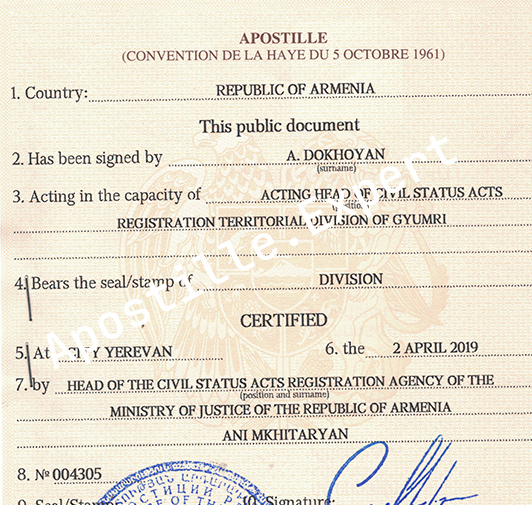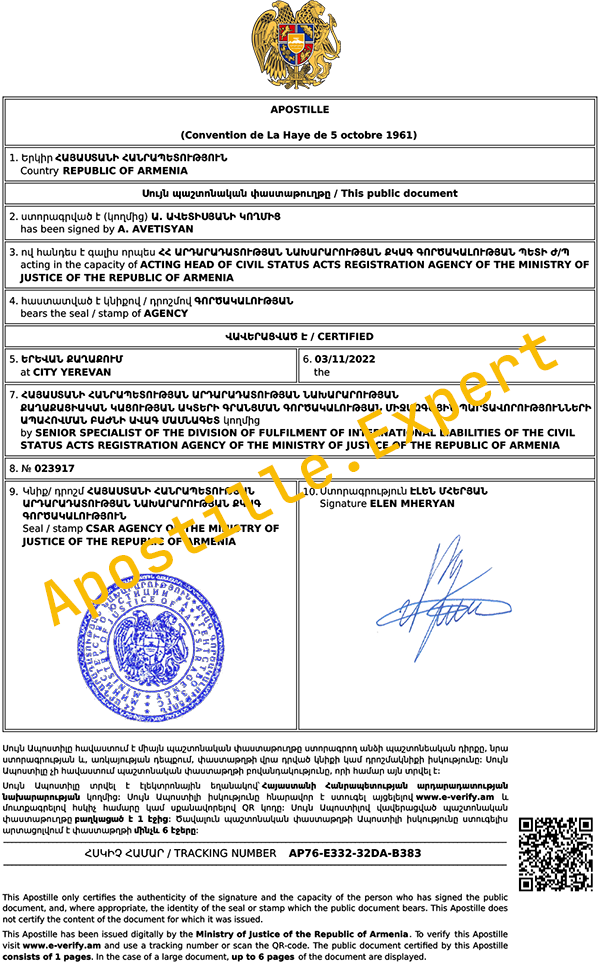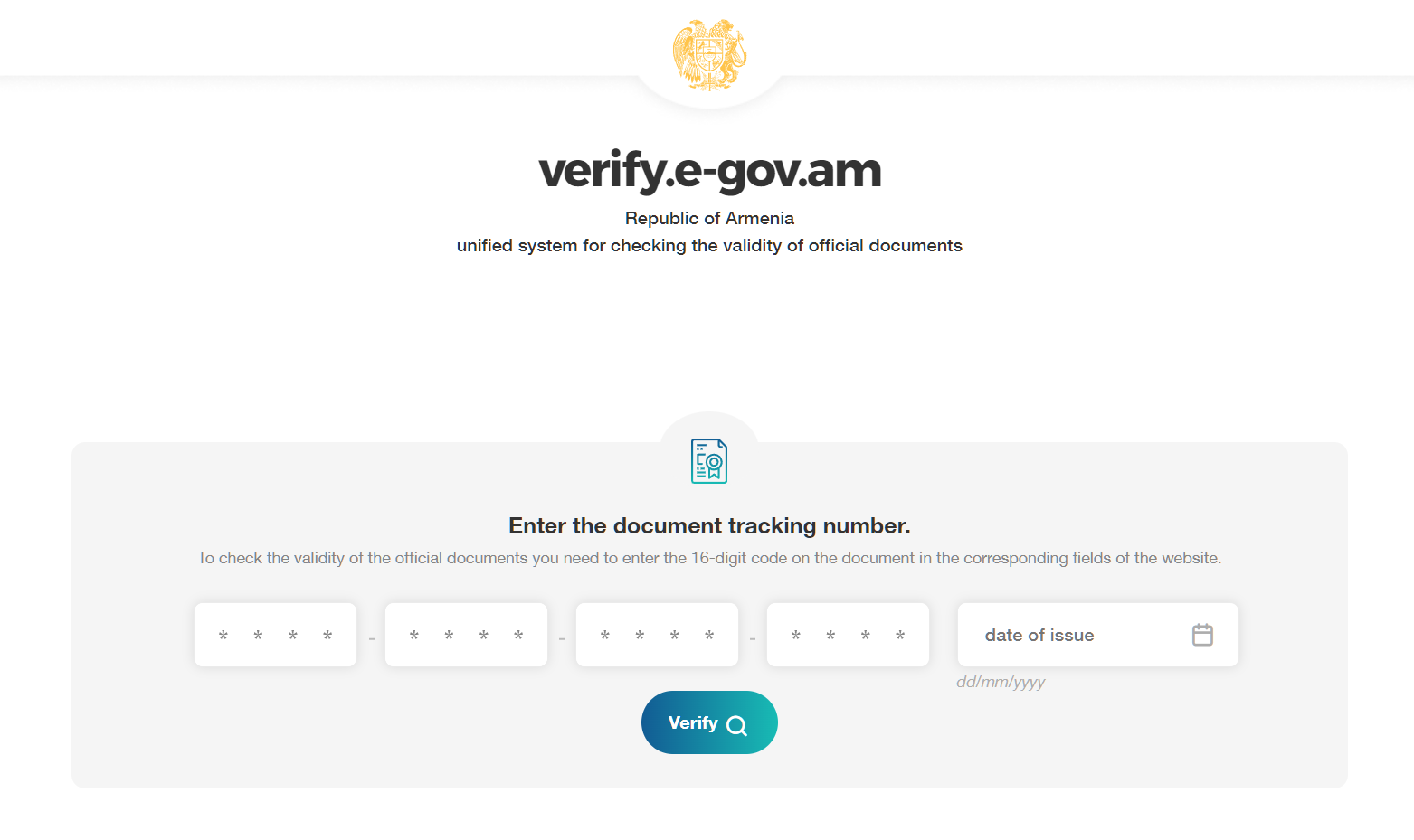Apostille of Armenia
What is an Armenian apostille?
The Armenian apostille is a stamp, the form, content, and purpose of which are defined by the Apostille Convention of 1961.
But in Armenia, it is an electronic apostille that is printed on A4 paper. The apostille itself is 17 by 18 centimeters in size. Below the apostille is an instruction for its online verification, a QR code, and a so-called 16-character tracking number.
The bottom of the form indicates the total number of pages of the document certified by the Apostille (a maximum of 6 pages of the document are displayed when viewed).
There is no longer a physical apostille with a wet seal and signature in Armenia.
The old apostille, according to the Order of the Ministry of Justice of the Republic of Armenia on the approval of the procedure for affixing an apostille by the Ministry of Justice, was a strictly numbered document 14 by 14 cm in size, which was attached to the original document.
Armenia joined the Hague Convention “on the Apostille” as one of the first CIS countries on November 19, 1993. The apostille in Armenia became effective on August 14, 1994.
This means that documents obtained before August 1994 cannot be apostilled. Such documents need to be reissued as new sample documents.
An apostille in Armenia can be obtained in two languages: Armenian and English, regardless of whether the document is translated or not.
What does the Armenian Apostille look like?

Old apostille sample in Armenia. Such an apostille with a wet seal was used until 2021.
Despite the fact that such an apostille could be verified online, it was replaced by a new apostille sample.
A scan (color copy) of the Armenian apostille is the electronic apostille:

Text of the Armenian apostille
APOSTILLE (ԱՊՈՍՏԻԼ)
(Convention de La Haye du 5 octobre 1961)
(1961 թվականի հոկտեմբերի 5-ի Հաագայի կոնվենցիա)
APOSTILLE (ԱՊՈՍՏԻԼ)
(Convention de La Haye du 5 octobre 1961)
(1961 թվականի հոկտեմբերի 5-ի Հաագայի կոնվենցիա)
1. Երկիր ՀԱՅԱՍՏԱՆԻ ՀԱՆՐԱՊԵՏՈՒԹՅՈՒՆ
Սույն պաշտոնական փաստաթուղթը
2. ստորագրված է (կողմից): ___________________________
3. ով հանդես է գալիս որպես ՀՀ ԱՐԴԱՐԱԴԱՏՈՒԹՅԱՆ ՆԱԽԱՐԱՐՈՒԹՅԱՆ ՔԿԱԳ ԳՈՐԾԱԿԱԼՈՒԹՅԱՆ ՊԵՏԻ Ժ/Պ
4. հաստատված է կնիքով / դրոշմով ԳՈՐԾԱԿԱԼՈՒԹՅԱՆ
ՎԱՎԵՐԱՑՎԱԾ Է
5. ԵՐԵՎԱՆ ՔԱՂԱՔՈՒՄ
6. ամիսը, ամսաթիվը __________________
7. ՀԱՅԱՍՏԱՆԻ ՀԱՆՐԱՊԵՏՈՒԹՅԱՆ ԱՐԴԱՐԱԴԱՏՈՒԹՅԱՆ ՆԱԽԱՐԱՐՈՒԹՅԱՆ ՔԱՂԱՔԱՑԻԱԿԱՆ ԿԱՑՈՒԹՅԱՆ ԱԿՏԵՐԻ ԳՐԱՆՑՄԱՆ ԳՈՐԾԱԿԱԼՈՒԹՅԱՆ ՄԻՋԱԶԳԱՅԻՆ ՊԱՐՏԱՎՈՐՈՒԹՅՈՒՆՆԵՐԻ
ԱՊԱՀՈՎՄԱՆ ԲԱԺՆԻ ԱՎԱԳ ՄԱՍՆԱԳԵՏ կողմից
8. № ____________________
9. Կնիք/ դրոշմ ՀԱՅԱՍՏԱՆԻ ՀԱՆՐԱՊԵՏՈՒԹՅԱՆ ԱՐԴԱՐԱԴԱՏՈՒԹՅԱՆ ՆԱԽԱՐԱՐՈՒԹՅԱՆ ՔԿԱԳ ԳՈՐԾԱԿԱԼՈՒԹՅՈՒՆ
10. Ստորագրություն ____________
Armenian apostille in English
APOSTILLE
(Convention de La Haye du 5 octobre 1961)
1. Country REPUBLIC OF ARMENIA
This public document
2. has been signed by: ___________________________
3. acting in the capacity of ACTING HEAD OF CIVIL STATUS ACTS REGISTRATION AGENCY OF THE MINISTRY OF JUSTICE OF THE REPUBLIC OF ARMENIA
4. bears the seal / stamp of AGENCY
CERTIFIED
5. at CITY YEREVAN
6. the __________________
(note BUSINESS LAWYERS SRL: the date of sign and apostille)
7. by: ________________
8. Nr. ____________________
9. Seal / stamp AGENCY OF THE MINISTRY OF JUSTICE OF THE REPUBLIC OF ARMENIA
10. Signature _____________
Why is an apostille needed if documents from Armenia already have an official’s seal and signature?
The thing is, many officials work in ministries, departments, state bodies, archives, and civil registry offices in Armenia.
Officials change periodically. This means there are many signatures, and they also change. To ensure the originality and authenticity of a document and to avoid counterfeits, one needs to check if an official’s signature matches the sample of their signature and whether they actually signed the document.
Considering the number of documents and officials, this is very challenging. Especially, it’s multiple times harder for officials who receive your documents abroad.
That’s why a system was developed to verify all signatures and seals by a few individuals – to facilitate the work of foreign officials. This also reduces the time taken to review documents abroad and the waiting time for applicants. In such a system, local officials responsible for the Apostille find it easier to verify signatures, seals, and the documents themselves (their forms and content).
In the absence of a sample signature of the official who signed the document, an apostille can only be affixed after the notarial certification of the authenticity of the signature on the document or a copy of the document. After which, the apostille is affixed to the authentic copy of the document at the person’s request.
Employees who have access to the internal database of signatures, seals, and document samples also fall into a special register with their signatures. But this register is limited to a handful of signatures, the samples of which are passed on to partner countries or easily checked by them in other ways.
There are two procedures for such confirmation. The first procedure, which is the most reliable, is called document legalization. When an official signs a document, a ministry staff member (usually from the Ministry of Foreign Affairs) certifies it. Then, this last signature is verified and certified by the consulate of the country where the documents need to be submitted. The verification is based on a current database (list) of signatures – following a chain from three different agencies (institutions, state bodies).
The second procedure is based on a higher level of trust and usually bypasses one agency, typically the Ministry of Foreign Affairs. Here, we’re talking about the apostille. An apostille is a special stamp of a set format that greatly simplifies the procedure of recognizing documents from one country within another.
Why get an apostille when Armenian documents can be verified online?
In the future, with digitization of documents and electronic signatures, the apostille procedure will become obsolete. However, Armenia signed the Apostille Convention and must adhere to the established rules. Moreover, a double-check of a document ensures its authenticity.
Can an apostille be obtained at the Armenian consulate?
According to the Hague Apostille Convention, an apostille for Armenian documents cannot be obtained at the Armenian consulate. The only option is if the consulate requests the document from the appropriate agency in the country. If the consulate itself issues the document (produces it), then such a document cannot be apostilled. This does not depend on the country where the consulate is located, be it Russia, Greece, England, etc.
How can you verify an electronic apostille in Armenia?
E-apostille or electronic apostille in different countries has several verification options.
1. In some countries, it’s a code to be entered into verification fields.
2. In others, it’s a QR code that, when scanned, displays the official document or apostille.
3. There’s also a verification method for the electronic signature attached to the apostille.
In Armenia, the first two methods are combined. First, the QR code is scanned, then the user navigates to a page with the document code and enters the date the apostille was affixed.
To verify an electronic apostille, one should use the Armenian government website – www.e-verify.am.
